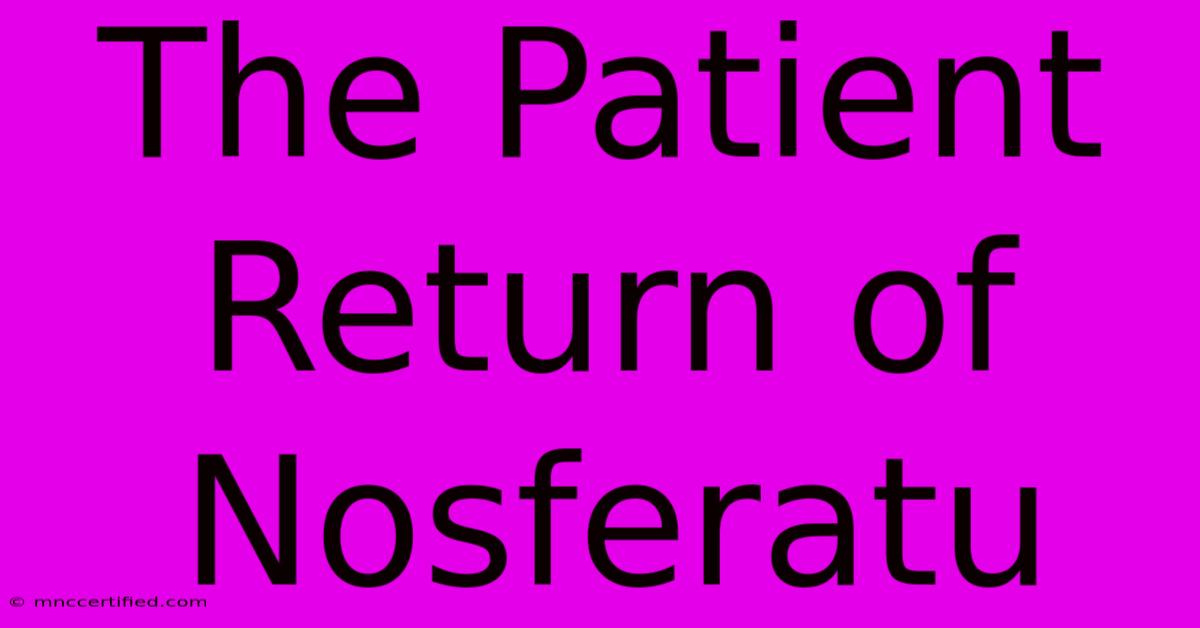The Patient Return Of Nosferatu

Table of Contents
The Patient Return of Nosferatu: A Century of Cinematic Shadows
The name "Nosferatu" evokes immediate images: elongated fingers, a gaunt visage, and the chilling whisper of impending doom. A century after its controversial release, F.W. Murnau's 1922 silent film, Nosferatu, eine Symphonie des Grauens (Nosferatu, a Symphony of Horror), continues to cast a long shadow over cinematic history, influencing countless horror films and solidifying its place as a cornerstone of the genre. This article delves into the film's enduring legacy, exploring its production, its impact, and its surprising resurgence in the modern age.
A Shadowy Birth: The Production of Nosferatu
The creation of Nosferatu wasn't without its own dark drama. Producer Albin Grau, captivated by Bram Stoker's Dracula, attempted to secure the rights to adapt it. However, he failed to obtain permission, leading to a blatant copyright infringement that would haunt the film's history. This unauthorized adaptation forced the destruction of all existing prints after its initial release, ironically contributing to its legendary status. The surviving copies, often damaged and incomplete, only amplify the film's mysterious aura.
Max Schreck: The Unforgettable Count Orlok
The film's success hinges on Max Schreck's unforgettable portrayal of Count Orlok. Schreck's performance, a masterclass in unsettling stillness and predatory grace, is arguably the most iconic vampire portrayal in cinema history. His gaunt features, piercing gaze, and unsettling movements still manage to evoke a visceral sense of dread, even a century later. The mystery surrounding Schreck himself – his real name, his stage experience, and even his death – only adds to the legend surrounding his iconic role.
The Enduring Legacy: Influence and Reinterpretation
Nosferatu's influence on subsequent horror films is undeniable. Its groundbreaking use of expressionist cinematography, with its stark shadows, distorted perspectives, and unsettling camerawork, paved the way for countless horror masterpieces. The film's innovative use of shadows and light, often used to represent both the physical and psychological darkness of the vampire, continues to inspire filmmakers today.
Beyond the Shadows: Modern Interpretations
Despite its age, Nosferatu continues to be relevant. Numerous filmmakers have paid homage to Murnau's classic, either through direct references or by incorporating its stylistic elements into their own work. The film's themes of disease, death, and societal anxieties remain eerily relevant in modern times, constantly prompting reinterpretations and discussions. This enduring relevance ensures that Nosferatu remains a powerful and thought-provoking piece of cinema.
The Silent Symphony: Sound and Restoration
While originally a silent film, the lack of a traditional score hasn't diminished its power. Modern screenings often feature specially composed scores that enhance the film’s atmosphere and emotional impact, adding layers of depth to the original experience. The ongoing restoration efforts ensure that new generations can appreciate the artistry of Murnau’s original vision, mitigating the damage caused by time and neglect. The meticulous restoration work allows audiences to experience the film’s visual artistry in a much clearer and more complete way than ever before.
Conclusion: A Symphony of Horror That Endures
Nosferatu's journey from a controversial unauthorized adaptation to a cinematic masterpiece is a testament to its enduring power. Its innovative cinematography, unsettling performance by Max Schreck, and timeless themes of fear and the unknown continue to resonate with audiences a century later. The film's legacy extends far beyond the screen, influencing countless artists and filmmakers, solidifying its place as a cornerstone of horror cinema and a testament to the power of the enduring image. The silent symphony continues to play, its haunting melody echoing through the annals of cinematic history.
Keywords: Nosferatu, Max Schreck, F.W. Murnau, silent film, German Expressionism, horror film, vampire, Count Orlok, Bram Stoker, Dracula, cinematic legacy, film restoration, film history, classic horror, expressionist cinematography.

Thank you for visiting our website wich cover about The Patient Return Of Nosferatu. We hope the information provided has been useful to you. Feel free to contact us if you have any questions or need further assistance. See you next time and dont miss to bookmark.
Featured Posts
-
Chiefs Faceoff Mahomes And Worthy
Dec 26, 2024
-
Kazakhstan Crash Azerbaijan Airlines 38 Fatalities
Dec 26, 2024
-
Azerbaijan Jet Crash Kills Dozens In Kazakhstan
Dec 26, 2024
-
Best Ps 5 Games This Holiday
Dec 26, 2024
-
Whos Back In Vengeance Most Fowl
Dec 26, 2024